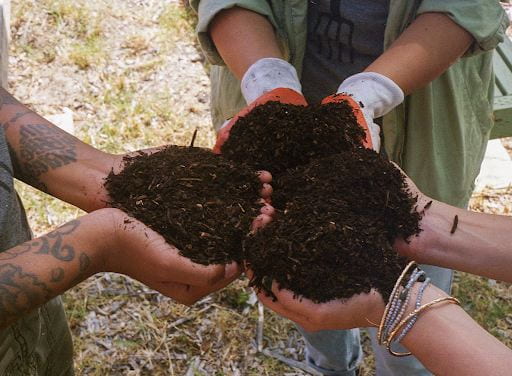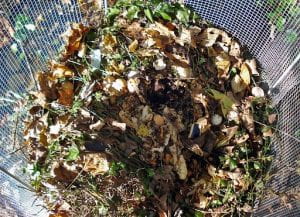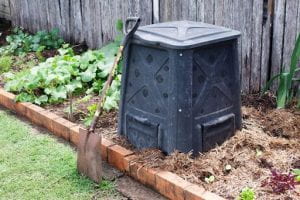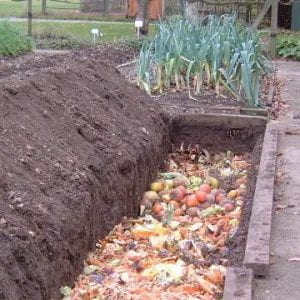Composting 101
Compost: What is it?
In essence, compost refers to the phase of a natural decomposition process of organic matter and dirt that creates a hyper-fertile soil called humus. The decomposition is aerobic, meaning it requires oxygen, compared to anaerobic processes such as fermentation. Heat is also generated (up to 140°F!) from the rapid decomposition. Often referred to as “black gold” by farmers and gardeners, compost is rich and dark in color, crumbly in texture, and packed full of plant nutrients, beneficial organisms, and microbes such as worms, bacteria, nematodes, protozoa, and fungi. These components all come together to create a very effective soil fertilizer and conditioner. This nutrient rich compost is added to soil to improve its quality, i.e. improve the texture (fluffy and brown is goal), integrate organic nutrients (industrial fertilizers often lack the full range of nutrients provided by compost), and introduce microorganisms and fauna that help synthesize nutrients and fight against pathogens and plant disease.

Image by Kari Steele via https://www.facebook.com/CommissionerKariSteele/posts/steele-water-definition-compost-is-organic-matter-that-has-been-decomposed-in-a-/2070093916470638/
Now that we know what compost is, we can review what materials can be used in a home compost pile!
Compost Ingredients
In order for the decomposition process to be successful, a compost pile needs a ratio of four main ingredients: carbon, nitrogen, water, and oxygen. The carbon component comes from “brown” materials and waste, woody materials such as dry leaves, sawdust, hay, shredded paper, and corn stalks. The brown ingredients provide food and energy for the microorganisms in the compost. The nitrogen is instead provided by “green” material, such as food scraps, animal byproducts, pulled weeds, cut grass, and other moist green material. The nitrogen creates protein elements needed for microorganism growth and reproduction.
The general ratio of ingredients is 3 parts brown material to 1 part green material, and enough water to give the mixture the wetness of a damp sponge. The oxygen component is achieved by turning the mixture occasionally, which aerates the material.
GOOD Home Compost Ingredients:
-

Image via Megannn / flickr
Food waste [fruits, vegetables, bread, etc] (green)
- Non-coated paper and cardboard (brown)
- Eggshells (green)
- Coffee grounds (green)
- Straw (brown)
- Dry leaves and pine needles (brown)
- Manure (green)
- Hair (green)
- Animal and fish bones/fur (green)
- Sawdust and wood shavings (brown)
- Yard trimmings and plant debris (green)
- Cotton and wool (brown)
- Vacuum and dryer lint (brown)
BAD Home Compost Ingredients:
- Dairy products (creates a bad smell and attracts pests)
- Meat (creates a bad smell and attracts pests)
- Coal and charcoal ash (contains plant-harming chemicals)
- Pet waste/excrements (can contain parasites, harmful germs and bacteria)
- Black walnut (releases plant-harming substances)
- Fat, grease, lard, oils (odor problems + attracts pests)
- Diseased or insect-infested plants (disease/ insects may survive and be transferred)
Ways to Compost
Composting can seem intimidating, especially if one doesn’t have access to outdoor space. Luckily, you can compost outdoors or indoors with no problem! The process can be tailored to your specific conditions, such as where you live and how much space you have available, how much and what types of organic waste you produce, and how much time you are able to invest in composting. When done correctly, a compost pile will not smell or attract pests, and will yield nutrient-rich humus after 2 months to 2 years, depending on the method of composting.
If you have access to a yard or outdoor space, you have a few more options to choose from when setting up your compost system. There are a couple of beginner-friendly methods of composting: bin composting and trench composting.
Bin Composting: this method involves using a receptacle to store your compost and house the decomposition process. This is also the best method for indoor composting, as everything is nicely contained. The ideal size for a compost bin is three cubic feet, as anything larger would take longer to break down. It is important that the bin has some sort of air vents or holes to allow for aeration. If one is doing bin composting outdoors, the bin can be open or closed with a removable top; the bottom of the bin can also be removed so the compost can be in direct contact with the soil below. Open outdoor bins work equally well, but they do run more of a risk of attracting pests.

Image by David Freund via Getty Images
Trench Composting: this method is great if you want to do a one-time compost rather than an ongoing pile. You dig a hole or trench (three cubic feet) and fill with your compost material, then cover with soil. The decomposition will take place underground and benefit the surrounding plants by supplying them with nutrients and helping reinforce their root systems. Willingly, one could also use the trench composting method like the bin composting method by keeping the ditch open and covering it with a tarp.

Image by Suzanne Seryck via https://peterboroughmastergardeners.com/2018/05/28/trench-or-hole-composting/
Go Forth and Compost!
Composting is one of the easiest ways we as individuals can reduce our food waste. It’s a simple process that doesn’t require any additional material or extraneous effort. Also, it produces an extremely valuable and underappreciated resource: healthy, fertile dirt.
Some cities like San Francisco offer municipal composting systems, in which either the city or a private organization collects organic waste from the community and takes it to specialized, decentralized composting facilities. Municipal composting is a great option when it is available; aside from ensuring that your organic waste will be properly composted by professionals, municipal composting also has a wider range of acceptable materials, such as animal byproducts, carcasses, and other waste materials that would cause problems in a home compost system.
Sources
“All About Composting: Learn How to Compost From Gardener’s Supply.” www.gardeners.com, www.gardeners.com/how-to/all-about-composting/5061.html. Accessed 26 Oct. 2022.
“Composting at Home.” US EPA, 7 July 2022, www.epa.gov/recycle/composting-home.
Hu, Shelia. “Composting 101.” NRDC, www.nrdc.org/stories/composting-101. Accessed 26 Oct. 2022.
O2Compost. (n.d.). Get a quote on your compost system today! Municipal Compost Systems. Retrieved December 7, 2022, from https://www.o2compost.com/municipal-composting-systems.aspx


